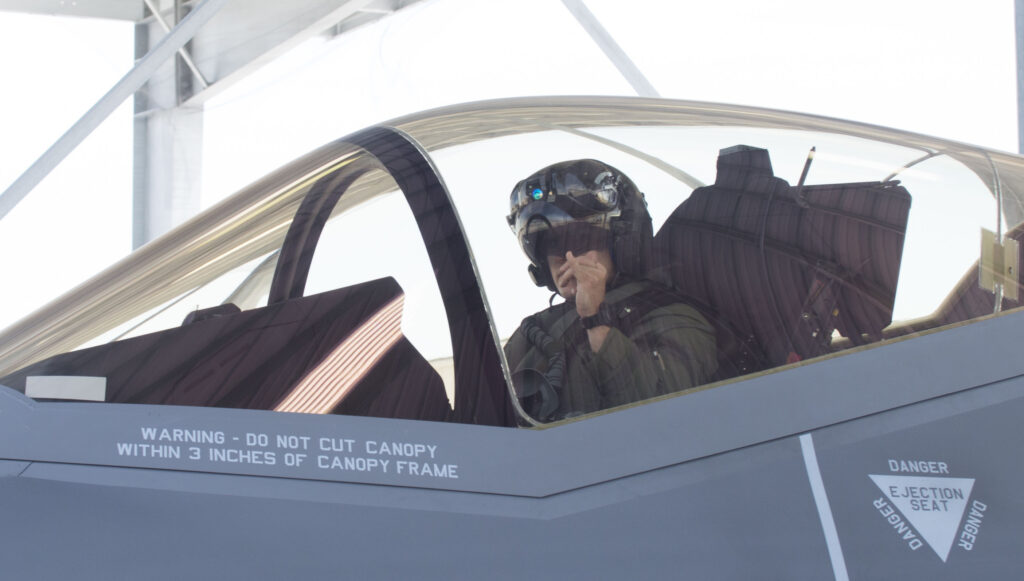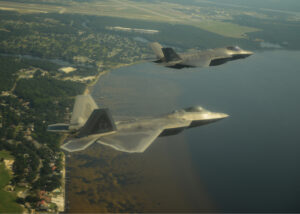
Lt. Col. Chris Pitts in F-35A at Mountain Home AFB
RIAT: No roadblocks stand in the way of approving Initial Operating Capability (IOC) for the Air Force’s F-35A, Gen. Hawk Carlisle said here today.
The head of Air Combat Command — who is the man charged with ensuring Lockheed Martin meets all the benchmarks for IOC — made clear nothing would happen until Air Force Secretary Deborah Lee James and Chief of Staff Gen. David Goldfein say the aircraft is ready, but he was extremely bullish.
“Nothing” in the program warrants a yellow or red designation, he averred, not even the troubled aircraft logistics system known as ALIS, an integral part of the F-35 program. “It’s not yellow or red, but it’s not as green as everything else,” Carlisle said, clearly aware of his audience of some 105 journalists from the UK and US. The Air Force’s F-35A is flying here, along with the F-35B, flown by Britain and the Marine Corps.
The Air Force plan is to declare IOC sometime between August 1 and the end of the year, if the program meets its requirements. “I personally believe we’ll be able to declare IOC at the bleeding edge of that window,” Carlisle said.
A key factor in Carlisle’s assessment was clearly the recent engagement at Mountain Home Air Force Base, where seven F-35As and 160 personnel from Hill AFB deployed for two weeks in the first half of June. The aircraft flew all 88 planned sorties. In target practice, they dropped 16 GBU-39 bombs and one missed. But that was a problem with the bomb, Carlisle noted, and not with the aircraft. Altogether, 39 of 40 weapons hit their targets for a 97.5 percent hit rate. And the aircraft boasted a “really, really exceptional” 92.3 mission capable rate. “It gives me a lot of confidence when I start thinking about IOC when as a capstone deployment that’s what happens,” Carlisle said.
In an intriguing comment, the head of Air Combat Command also said the F-35’s rarely discussed Electronic Warfare capabilities are “an order of magnitude better than anything we’ve had in the past.”
 Carlisle also joined Secretary James in expressing skepticism about restarting production of the F-22. The general, considered one of the Raptor’s biggest supporters in the US military, said that “money is better spent” keeping production rates high for the F-35 — and, consequently, keeping costs down — instead of restarting the F-22 line. While noting this is “very much a personal opinion,” it would appear to put the kibosh on the idea. If Carlisle doesn’t support it, only direct action could lead to an F-22 restart,
Carlisle also joined Secretary James in expressing skepticism about restarting production of the F-22. The general, considered one of the Raptor’s biggest supporters in the US military, said that “money is better spent” keeping production rates high for the F-35 — and, consequently, keeping costs down — instead of restarting the F-22 line. While noting this is “very much a personal opinion,” it would appear to put the kibosh on the idea. If Carlisle doesn’t support it, only direct action could lead to an F-22 restart,
I asked the general about a push by California lawmakers, including the powerful Sen. Diane Feinstein, to delay retirement of the U-2 for some time. After noting that the U-2 can do some things the Global Hawk can’t because of the altitudes it can reach, he made sure to note that the aging aircraft, is “increasingly hard to maintain” and it can be “costly” to keep flying. The timing of the U-2’s retirement is one that the Air Force will “discuss with Congress,” he noted dryly.
In another issue sure to draw the attention of Sen. Kelly Ayotte and her band of brother lawmakers who refuse to retire the A-10 Warthog, Carlisle said the Air Force has concluded that going with a next-generation Close Air Support weapons system “looks more attractive than trying to keep the A-10 flying infinitely longer.” He also told me that F-35A has proven it “does basic CAS very well” and can execute Close Air Support missions when “other planes can’t” because they would be shot down.
In a ‘world first,’ DARPA project demonstrates AI dogfighting in real jet
“The potential for machine learning in aviation, whether military or civil, is enormous,” said Air Force Col. James Valpiani. “And these fundamental questions of how do we do it, how do we do it safely, how do we train them, are the questions that we are trying to get after.”


























